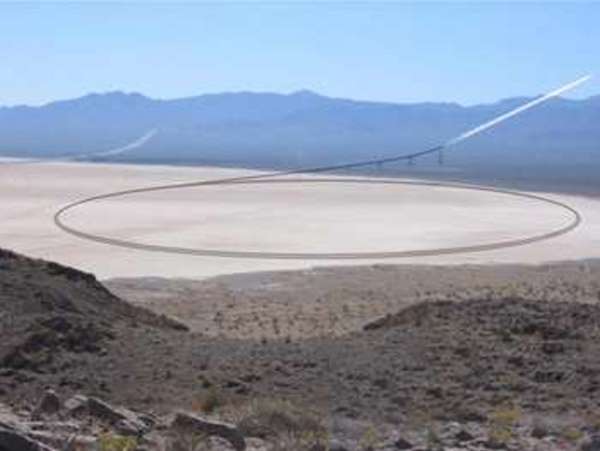|
Magnetic Levitation |
|
|
..
The Launch Ring, a vast circle of superconducting magnets capable of hurling satellites and other cargo into space, is the subject of a new two-year study financed by the USAF. The study will be carried out by LaunchPont Technologies, based in Goleta, California. The study will be led by James Fiske, who has done advanced work in designing maglev (magnetic levitation) freight transportation systems. The Launch Ring will be similar in some ways to the enormous particle accelerators already in use. Most importantly, the device will (as its name implies) use a circular track, rather than the straight track considered in earlier designs (not to mention being considered in early science fiction novels). The system would work by gradually accelerating a sled with a cone-shaped shell containing the cargo to a speed of ten kilometers per second. The shell would then separate from its sled and slide into a side tunnel angled at thirty degrees upward. The cone would emerge from the tunnel with a net speed of about eight kilometers per second, sufficient to achieve orbit. The shell would also contain some fuel for trajectory adjustment and placement in a proper orbit. One disadvantage would be the substantial acceleration forces encountered when circling the ring at speed - up to 2,000 g's. The company points out that the US military uses electronics in laser-guided artillery, which survive being fired out of guns at up to 20,000 g's. Key to the proposed usefulness of the Launch Ring is the hoped-for low cost to orbit. The cost per pound to orbit is about $6,000 for the space shuttle; it is estimated that if the Launch Ring is used 300 times per year, the cost would be about $745 per pound. If this study pans out, funding would be sought for a small 20-50 meter diameter model, which would take at least four years to build. Obviously, we won't be launching payloads this way for quite some time, but this is a good first step. Science fiction writer Robert Heinlein also thought about the concept of a similar launching device. In his novel The Moon is a Harsh Mistress, published in 1966, he wrote about an escape-speed induction catapult built on the Moon. In the novel, the Loonies have this advice for a similar device to built on Earth: "...But the site must be a high mountain. It's that air pressure you spoke of, or air density. The catapult head should be at as high altitude as feasible but the ejection end, where the load travels over eleven kilometers per second, must be in air so thin that it approaches vacuum. Which calls for a very high mountain. Take the peak Nanda Devi, around four hundred kilometers from here. It has a railhead sixty kilometers from it and a road almost to its base. It is eight thousand meters high. I don't know that Nanda Devi is ideal. It is simply a possible site with good logistics; the ideal site would have to be selected by Terran engineers."Read more about the Launch Ring and visit the LaunchPoint magnetic satellite launch system page. Thanks to Baja for writing in with the tip on the story. Scroll down for more stories in the same category. (Story submitted 10/6/2006) SOURCE: Technovelgy.com Related Links: |
|
| FAIR USE NOTICE: This page contains copyrighted material the use of which has not been specifically authorized by the copyright owner. Pegasus Research Consortium distributes this material without profit to those who have expressed a prior interest in receiving the included information for research and educational purposes. We believe this constitutes a fair use of any such copyrighted material as provided for in 17 U.S.C § 107. If you wish to use copyrighted material from this site for purposes of your own that go beyond fair use, you must obtain permission from the copyright owner. | |
|
|

